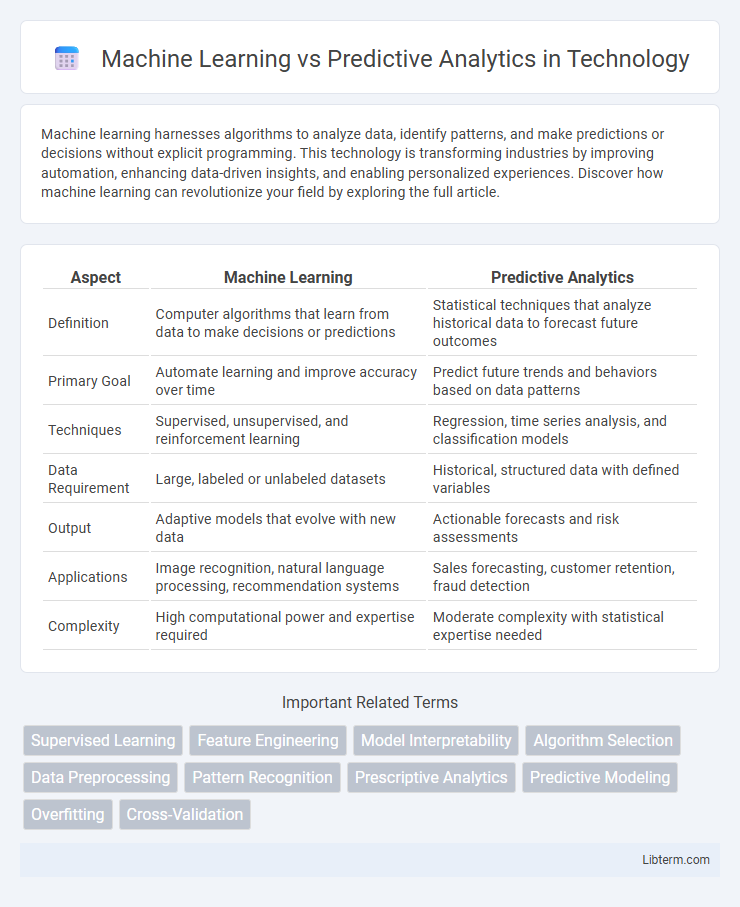Machine learning harnesses algorithms to analyze data, identify patterns, and make predictions or decisions without explicit programming. This technology is transforming industries by improving automation, enhancing data-driven insights, and enabling personalized experiences. Discover how machine learning can revolutionize your field by exploring the full article.
Table of Comparison
| Aspect | Machine Learning | Predictive Analytics |
|---|---|---|
| Definition | Computer algorithms that learn from data to make decisions or predictions | Statistical techniques that analyze historical data to forecast future outcomes |
| Primary Goal | Automate learning and improve accuracy over time | Predict future trends and behaviors based on data patterns |
| Techniques | Supervised, unsupervised, and reinforcement learning | Regression, time series analysis, and classification models |
| Data Requirement | Large, labeled or unlabeled datasets | Historical, structured data with defined variables |
| Output | Adaptive models that evolve with new data | Actionable forecasts and risk assessments |
| Applications | Image recognition, natural language processing, recommendation systems | Sales forecasting, customer retention, fraud detection |
| Complexity | High computational power and expertise required | Moderate complexity with statistical expertise needed |
Understanding Machine Learning: Key Concepts
Machine learning involves algorithms that enable computers to learn from data patterns and improve decision-making without explicit programming, distinguishing it from traditional predictive analytics, which relies on statistical methods and predefined models. Key concepts in machine learning include supervised learning, unsupervised learning, reinforcement learning, and feature engineering, all crucial for building accurate predictive models. Understanding these foundational principles allows organizations to harness complex data structures and enhance predictive capabilities beyond conventional analytics techniques.
What Is Predictive Analytics?
Predictive analytics involves using historical data, statistical algorithms, and machine learning techniques to identify the likelihood of future outcomes based on patterns and trends. Key components include data mining, statistical modeling, and predictive modeling, enabling businesses to forecast customer behavior, market trends, and risk factors. Unlike broader machine learning, predictive analytics specifically targets actionable insights to improve decision-making and optimize performance across industries like finance, healthcare, and marketing.
Core Differences Between Machine Learning and Predictive Analytics
Machine learning involves algorithms that enable systems to learn patterns from data and improve automatically without explicit programming, focusing on model training and adaptation. Predictive analytics uses statistical techniques, including machine learning models, to analyze historical data and forecast future outcomes, emphasizing data interpretation and decision support. The core difference lies in machine learning's emphasis on automated learning processes, while predictive analytics centers on applying various methods, including machine learning, to predict specific future events.
Overlapping Areas: Where Machine Learning Meets Predictive Analytics
Machine learning and predictive analytics converge in extracting meaningful patterns from historical data to forecast future outcomes, leveraging algorithms like regression, decision trees, and neural networks. Both fields utilize data preprocessing, feature selection, and model evaluation techniques to improve prediction accuracy and business decision-making. This overlap enables enhanced insights in domains such as finance, healthcare, and marketing through automated learning and data-driven predictions.
Algorithms Used in Machine Learning vs Predictive Analytics
Machine Learning predominantly employs algorithms such as neural networks, support vector machines, and decision trees to automatically learn patterns from data without explicit programming. Predictive Analytics relies heavily on statistical models including regression analysis, time series forecasting, and classification techniques to predict future outcomes based on historical data. The key distinction lies in machine learning's ability to improve and adapt its algorithms with new data, whereas predictive analytics primarily uses predefined models to generate predictions.
Data Requirements and Preparation
Machine learning requires large volumes of diverse, high-quality data to build accurate models, often involving extensive data cleaning, normalization, and feature engineering to improve algorithm performance. Predictive analytics relies heavily on structured historical data, requiring precise data integration and transformation to identify relevant patterns and trends for forecasting. Both disciplines emphasize the importance of data preparation, but machine learning typically demands more complex preprocessing techniques to handle unstructured or semi-structured data sources.
Use Cases: Machine Learning vs Predictive Analytics in Business
Machine learning drives personalized customer experiences by analyzing vast datasets to detect patterns and automate decision-making, enhancing marketing strategies and product recommendations. Predictive analytics forecasts sales trends, customer churn, and risk assessment using statistical models, enabling businesses to optimize inventory and improve operational efficiency. Together, these technologies empower companies to leverage data-driven insights for strategic growth and competitive advantage.
Benefits and Limitations of Each Approach
Machine Learning offers robust pattern recognition and adaptability in handling large, complex datasets, enabling predictive models to improve over time with minimal human intervention. Predictive Analytics excels in leveraging historical data and statistical techniques to generate actionable business insights, delivering transparent and interpretable results for decision-making. Limitations of Machine Learning include the need for extensive data preprocessing and potential model overfitting, while Predictive Analytics may struggle with nonlinear relationships and less dynamic data environments.
How to Choose the Right Solution for Your Organization
Selecting the right solution between machine learning and predictive analytics depends on your organization's data complexity and specific business goals. Machine learning excels with large, unstructured datasets and offers advanced pattern recognition, making it ideal for dynamic environments requiring continuous learning. Predictive analytics suits organizations with structured data focused on forecasting and decision support through statistical models, ensuring easier implementation and clearer insights.
The Future of Machine Learning and Predictive Analytics
The future of machine learning and predictive analytics is driven by advancements in artificial intelligence algorithms and big data integration, enabling more accurate real-time decision-making across industries. Innovations in automated machine learning (AutoML) and hybrid models combining predictive analytics with deep learning will enhance model interpretability and scalability. Increased adoption of edge computing and explainable AI (XAI) will further optimize predictive capabilities, shaping smarter business strategies and personalized user experiences.
Machine Learning Infographic

 libterm.com
libterm.com